|
War Language
War (also spelled Waar), also known as War-Jaintia, is an Austroasiatic language spoken by about 16,000 people in Bangladesh and 51,000 people in India.Sidwell, Paul. 2018. ''The Khasian Languages: Classification, Reconstruction, and Comparative Lexicon''. Languages of the World 58. Munich: Lincom Europa. The language is spoken by the ''War Khasi tribe'', i.e. ''War'' sub-tribe of Khasi people. See also * Languages of India Languages spoken in India belong to several language families, the major ones being the Indo-European languages spoken by 78.05% of Indians and the Dravidian languages spoken by 19.64% of Indians, both families together are sometimes known ... References Khasian languages Languages of Bangladesh Languages of India Languages of Meghalaya {{AustroAsiatic-lang-stub ... [...More Info...] [...Related Items...] OR: [Wikipedia] [Google] [Baidu] |
India
India, officially the Republic of India (Hindi: ), is a country in South Asia. It is the seventh-largest country by area, the second-most populous country, and the most populous democracy in the world. Bounded by the Indian Ocean on the south, the Arabian Sea on the southwest, and the Bay of Bengal on the southeast, it shares land borders with Pakistan to the west; China, Nepal, and Bhutan to the north; and Bangladesh and Myanmar to the east. In the Indian Ocean, India is in the vicinity of Sri Lanka and the Maldives; its Andaman and Nicobar Islands share a maritime border with Thailand, Myanmar, and Indonesia. Modern humans arrived on the Indian subcontinent from Africa no later than 55,000 years ago., "Y-Chromosome and Mt-DNA data support the colonization of South Asia by modern humans originating in Africa. ... Coalescence dates for most non-European populations average to between 73–55 ka.", "Modern human beings—''Homo sapiens''—originated in Africa. Then, int ... [...More Info...] [...Related Items...] OR: [Wikipedia] [Google] [Baidu] |
Bangladesh
Bangladesh (}, ), officially the People's Republic of Bangladesh, is a country in South Asia. It is the eighth-most populous country in the world, with a population exceeding 165 million people in an area of . Bangladesh is among the most densely populated countries in the world, and shares land borders with India to the west, north, and east, and Myanmar to the southeast; to the south it has a coastline along the Bay of Bengal. It is narrowly separated from Bhutan and Nepal by the Siliguri Corridor; and from China by the Indian state of Sikkim in the north. Dhaka, the capital and largest city, is the nation's political, financial and cultural centre. Chittagong, the second-largest city, is the busiest port on the Bay of Bengal. The official language is Bengali, one of the easternmost branches of the Indo-European language family. Bangladesh forms the sovereign part of the historic and ethnolinguistic region of Bengal, which was divided during the Partition of India in ... [...More Info...] [...Related Items...] OR: [Wikipedia] [Google] [Baidu] |
Meghalaya
Meghalaya (, or , meaning "abode of clouds"; from Sanskrit , "cloud" + , "abode") is a states and union territories of India, state in northeastern India. Meghalaya was formed on 21 January 1972 by carving out two districts from the state of Assam: (a) the United Khasi Hills and Jaintia Hills and (b) the Garo Hills.History of Meghalaya State Government of India Meghalaya was previously part of Assam, but on 21 January 1972, the districts of Khasi, Garo and Jaintia Hills became the new state of Meghalaya. The population of Meghalaya as of 2014 is estimated to be 3,211,474. Meghalaya covers an area of approximately 22,430 square kilometres, with a length-to-breadth ratio of about 3:1.Meghal ... [...More Info...] [...Related Items...] OR: [Wikipedia] [Google] [Baidu] |
Sylhet Division
Sylhet Division ( bn, সিলেট বিভাগ) is the northeastern division of Bangladesh. It is bordered by the Indian states of Meghalaya, Assam and Tripura to the north, east and south respectively, and by the Bangladeshi divisions of Chittagong to the southwest and Dhaka and Mymensingh to the west. Prior to 1947, it included the subdivision of Karimganj (presently in Barak Valley, India). However, Karimganj (including the thanas of Badarpur, Patharkandi and Ratabari) was inexplicably severed from Sylhet by the Radcliffe Boundary Commission. According to Niharranjan Ray, it was partly due to a plea from a delegation led by Abdul Matlib Mazumdar. Etymology and names The name ''Sylhet'' is an anglicisation of ''Shilhot'' (শিলহট). Its origins seem to come from the Sanskrit words শিলা ''śilā'' (meaning 'stone') and হট্ট ''haṭṭa'' (meaning 'marketplace'). These words match the landscape and topography of the hilly region. The shila stones ... [...More Info...] [...Related Items...] OR: [Wikipedia] [Google] [Baidu] |
Khasi–Palaungic Languages
The Khasi–Palaungic languages are a primary branch of the Austroasiatic language family of Southeast Asia in the classification of Sidwell (2011, 2018). This is a departure from Diffloth (2005) classification of Khasi-Khmuic with Khmuic and Mangic (Pakanic) now being separate branches within Austroasiatic family. Languages As per the classification of Sidwell (2011) and (2018), the Khasi–Palaungic languages are as follows: * Khasi–Palaungic ** Khasic: War, Lyngngam, Khasi... ** Palaungic The nearly thirty Palaungic or Palaung–Wa languages form a branch of the Austroasiatic languages. Phonological developments Most of the Palaungic languages lost the contrastive voicing of the ancestral Austroasiatic consonants, with the disti ...: Palaung, Riang, Blang , Wa... Footnotes References *Diffloth, Gérard 2005. "The contribution of linguistic palaeontology and Austroasiatic". in Laurent Sagart, Roger Blench and Alicia Sanchez-Mazas, eds. ''The Peopling of Ea ... [...More Info...] [...Related Items...] OR: [Wikipedia] [Google] [Baidu] |
Khasic Languages
The Khasic or Khasian languages are a family of Austroasiatic languages spoken in the northeastern Indian state Meghalaya and neighbouring areas of Bangladesh. Languages Sidwell (2018: 27–31) classifies the Khasian languages as follows. ;Proto-Khasian *War (Amwi, Mnar) *Proto–Pnar-Khasi-Lyngngam ** Lyngngam (former Garo-speakers) ** Pnar (Jaintia), Khasi, Maharam (Maram) Varieties called ''Bhoi'' are dialects of both Pnar and Khasi. External relationships Paul Sidwell (2011) suggests that Khasian is closely related to Palaungic, forming a Khasi–Palaungic branch. The following eight Khasian-Palaungic isoglosses have been identified by Sidwell (2018: 32). Lexical innovations Sidwell (2018: 23) lists the following Khasian lexical innovations (i.e., defining lexical forms) that are found exclusively in the Khasian branch, but not in other Austroasiatic branches). Reconstruction Proto-Khasian and Proto-Pnar-Khasi-Lyngngam have been reconstructed by Paul Sidwell (2018). ... [...More Info...] [...Related Items...] OR: [Wikipedia] [Google] [Baidu] |
Austroasiatic
The Austroasiatic languages , , are a large language family A language family is a group of languages related through descent from a common ''ancestral language'' or ''parental language'', called the proto-language of that family. The term "family" reflects the tree model of language origination in h ... in Mainland Southeast Asia and South Asia. These languages are scattered throughout parts of Thailand, Laos, India, Myanmar, Malaysia, Bangladesh, Nepal, and southern China and are the majority languages of Vietnam and Cambodia. There are around 117 million speakers of Austroasiatic languages. Of these languages, only Vietnamese language, Vietnamese, Khmer language, Khmer, and Mon language, Mon have a long-established recorded history. Only two have official status as modern national languages: Vietnamese in Vietnam and Khmer in Cambodia. The Mon language is a recognized indigenous language in Myanmar and Thailand. In Myanmar, the Wa language is the de facto official la ... [...More Info...] [...Related Items...] OR: [Wikipedia] [Google] [Baidu] |
Khasi People
The Khasi people are an ethnic group of Meghalaya in north-eastern India with a significant population in the bordering state of Assam, and in certain parts of Bangladesh. Khasi people form the majority of the population of the eastern part of Meghalaya, that is Khasi Hills, constituting 78.3% of the region's population, and is the state's largest community, with around 48% of the population of Meghalaya. They are among the few Austroasiatic-speaking peoples in South Asia. The Khasi tribe holds the distinction of being one of the few remaining matriarchal tribes of the world. Under the Constitution of India, the Khasis have been granted the status of Scheduled Tribe. History Khasi mythology Khasi mythology traces the tribe's original abode to ("The Seven Huts"). According to the Khasi mythology, (God, the Lord Master) had originally distributed the human race into 16 heavenly families (). However, seven out of these 16 families were stuck on earth while the other 9 in heaven ... [...More Info...] [...Related Items...] OR: [Wikipedia] [Google] [Baidu] |
Languages Of India
Languages spoken in India belong to several language families, the major ones being the Indo-European languages spoken by 78.05% of Indians and the Dravidian languages spoken by 19.64% of Indians, both families together are sometimes known as Indic languages. Languages spoken by the remaining 2.31% of the population belong to the Austroasiatic, Sino–Tibetan, Tai–Kadai and a few other minor language families and isolates. As per the People's Linguistic Survey of India, India has the second highest number of languages (780), after Papua New Guinea (840). Ethnologue lists a lower number of 456. Article 343 of the Constitution of India stated that the official language of the Union is Hindi in Devanagari script, with official use of English to continue for 15 years from 1947. Later, a constitutional amendment, The Official Languages Act, 1963, allowed for the continuation of English alongside Hindi in the Indian government indefinitely until legislation decides to chang ... [...More Info...] [...Related Items...] OR: [Wikipedia] [Google] [Baidu] |
Khasian Languages
The Khasic or Khasian languages are a family of Austroasiatic languages spoken in the northeastern Indian state Meghalaya and neighbouring areas of Bangladesh. Languages Sidwell (2018: 27–31) classifies the Khasian languages as follows. ;Proto-Khasian *War (Amwi, Mnar) *Proto–Pnar-Khasi-Lyngngam ** Lyngngam (former Garo-speakers) ** Pnar (Jaintia), Khasi, Maharam (Maram) Varieties called ''Bhoi'' are dialects of both Pnar and Khasi. External relationships Paul Sidwell (2011) suggests that Khasian is closely related to Palaungic, forming a Khasi–Palaungic branch. The following eight Khasian-Palaungic isoglosses have been identified by Sidwell (2018: 32). Lexical innovations Sidwell (2018: 23) lists the following Khasian lexical innovations (i.e., defining lexical forms) that are found exclusively in the Khasian branch, but not in other Austroasiatic branches). Reconstruction Proto-Khasian and Proto-Pnar-Khasi-Lyngngam have been reconstructed by Paul Sidwell (2018). ... [...More Info...] [...Related Items...] OR: [Wikipedia] [Google] [Baidu] |
Languages Of Bangladesh
The national language and official language of Bangladesh is Bengali according to the third article of the Constitution of Bangladesh. The second most spoken language in Bangladesh is claimed to be Burmese which is spoken by the Marma tribe in Chittagong Hill districts as the districts border Myanmar; it is also spoken by the Rohingya people. 98% of Bangladeshis are fluent in Bengali (including dialects) as their first language. Bengali Language Implementation Act, 1987 made it mandatory to use Bengali in all government affairs except in the cases of foreign relations. According to a 2011 census, Bengali is predominantly spoken by 98% of the country's population and it also serves as the national language of the nation. The indigenous people of northern and southeastern Bangladesh speak a variety of native languages. Indo-Aryan languages The lowlands of Bangladesh form the larger, central, and eastern half of the ethno-linguistic region of Bengal and the Bengali language i ... [...More Info...] [...Related Items...] OR: [Wikipedia] [Google] [Baidu] |



